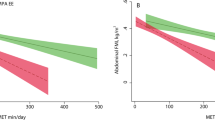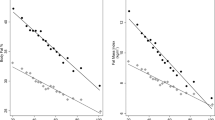Abstract
Objective: To assess total daily energy expenditure (TDEE) and patterns of physical activity among Swedish male and female adolescents and to relate the amount and intensity of physical activity to existing recommendations (energy expenditure equal to or above 12.4 kJ/kg/day or accumulation of 30 min/day in moderate physical activity equal to 4.5 times sedentary energy expenditure or more).
Design: TDEE, physical activity level (PAL=TDEE/BMR), energy expenditure (EE) and time spent in different intensities of physical activity were assessed by using minute-by-minute heart rate monitoring in combination with laboratory measured sedentary energy expenditure (SEE) and peak oxygen uptake.
Setting: Department of Physical Education and Health, Örebro University, and Department of Clinical Physiology, Örebro Medical Centre Hospital, Sweden.
Subjects: Eighty-two 14–15 y old adolescents (42 boys, 40 girls) from the city of Örebro, randomly selected through a two-stage sampling procedure.
Results: TDEE was 12.8 MJ/day and 10.0 MJ/day for boys and girls respectively (P<0.001) and PAL was 1.74 and 1.67 (NS). Forty-four percent and 47%, respectively, of TDEE referred to EE in physical activity, of which 70% for both genders referred to light physical activity (corresponding to <4.5 times SEE). Eleven boys and 14 girls had an EE lower than 12.4 kJ/kg/day and/or did not accumulate 30 min/day in physical activity ≥4.5 SEE. Those (n=20) with the highest PAL values (>2.01 and 1.81, respectively) spent 149 min/day at a ≥4.5 SEE intensity level compared to 40 min/day for those (n=30) with the lowest PAL values (<1.55 and 1.45, respectively).
Conclusions: Swedish adolescent boys and girls are similarly physically active. The major amount of time devoted to physical activity refers to light physical activity. At least thirty percent of adolescents seem not to achieve appropriate levels of physical activity considered to be beneficial for health.
Sponsorship: Örebro County Council, The Public Health Committee of Stockholm County Council, Sweducation Foundation.
European Journal of Clinical Nutrition (2000) 54, 195–202
This is a preview of subscription content, access via your institution
Access options
Subscribe to this journal
Receive 12 print issues and online access
$259.00 per year
only $21.58 per issue
Buy this article
- Purchase on Springer Link
- Instant access to full article PDF
Prices may be subject to local taxes which are calculated during checkout
Similar content being viewed by others
Author information
Authors and Affiliations
Contributions
Guarantors: U Ekelund and M Sjöström.
Contributors: UE initiated the study and was responsible for the design in collaboration with AY and MS. AN collected and organized the data. UE and AN did the data analysis. AY and MS participated in the interpretation and discussion of the results. UE was the main writer of the manuscript.
Corresponding author
Rights and permissions
About this article
Cite this article
Ekelund, U., Sjöström, M., Yngve, A. et al. Total daily energy expenditure and pattern of physical activity measured by minute-by-minute heart rate monitoring in 14–15 year old Swedish adolescents. Eur J Clin Nutr 54, 195–202 (2000). https://doi.org/10.1038/sj.ejcn.1600918
Received:
Revised:
Accepted:
Published:
Issue Date:
DOI: https://doi.org/10.1038/sj.ejcn.1600918
Keywords
This article is cited by
-
Late subadult ontogeny and adult aging of the human thorax reveals divergent growth trajectories between sexes
Scientific Reports (2020)
-
Physical activity, energy expenditure and their correlates in two cohorts of Swedish subjects between adolescence and early adulthood
European Journal of Clinical Nutrition (2005)
-
Daily energy expenditure, activity patterns, and energy costs of the various activities in French 12–16-y-old adolescents in free living conditions
European Journal of Clinical Nutrition (2002)
-
Assessment of Free-Living Physical Activity in Humans: An Overview of Currently Available and Proposed New Measures
Obesity Research (2001)



